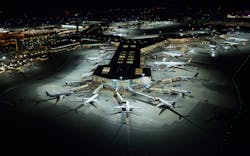Musco Lighting Illuminates the Future
Musco Lighting began developing new airfield lighting solutions more than 40 years ago. The company began with metal halide technology in 1976, and it has continually improved its operations to increase glare control and energy efficiency.
Musco began testing and applying LED technology on projects more than a decade ago. The company’s Total Light Control (TLC for LED) technology is one of its most recent innovations and was first introduced in 2016.
Adam DeJong, director of transportation and infrastructure for Musco Lighting, said choosing a reliable lighting system is important for any airport operation.
“Excessive spill and glare, low light levels and spotty coverage in high traffic volume areas can make it unsafe for pilots, air traffic controllers and ground crews to perform their jobs,” he said. “Many of these issues can be avoided by following recommended lighting guidelines defined by IES, ICAO or UFC.
“TLC for LED technology is the result of years of research and real-world experience,” he continued. “The fixture itself uses custom optics that provide greater efficiency and light uniformity, improving visibility for ground crews. Patented visoring eliminates glare from impacting the pilots and air traffic controls and allows us to preserve darkness in areas where light isn’t intended. The fixtures are dimmable, which allows airports to conserve energy when gates aren’t in use.”
DeJong said other features include easy-to-reach remote drivers, integrated grounding and surge protection to protect the LED’s sensitive electronic components to ensure their longevity.
The company offers a complete foundation-to-poletop system for new applications and modular lighting solutions for existing poles, specialty-use poles and roof-mounted structures. DeJong noted each airport will have its own unique needs, which is why the company offers various options.
“Every lighting project is different; there is no one-size-fits-all for apron lighting,” he said. “Each project is custom designed by our in-house application engineers to meet the needs of the customer. Our lighting solution designs use a system approach; the lights, structures and electrical components are engineered to work together. Every system is factory aimed, wired and tested for easy installation at the apron.”
Vancouver International Airport decided to use Musco Lighting's TLC for LED technology, which the company designed and retrofitted onto the airport's existing poles. The system includes electrical component equipment located remotely, lower on the poles which provides easy access for servicing.
Musco lighting also offers advanced control options that provide a cost-effective way to reduce energy usage, DeJong said.
“They allow you to select the amount of light you need from each luminaire based on activity,” he noted. “Users can set schedules based on use, manually select options or automate the controls with sensors or existing systems.
Customers can control the apron lighting from anywhere with the Control-Link app. This controls and monitoring system provides on/off control, dimming capabilities and system monitoring. The controls can be built to interface with new or existing facility management systems.
Control-Link gives airport managers adaptive controls based on gate usage. This means lighting levels will increase and decrease based on the gate schedule in order to save power when not in use.
The system can also reduce energy consumption. At McCarran International Airport, Musco’s lighting cut energy consumption by 54 percent compared to the prior lighting. It also reduced CO2 emissions by 7,601 metric tons over ten years.
Musco Lighting has a wide customer base for the TLC for LED technology, according to DeJong.
“We sell directly to airports of all sizes, FBOs and governmental/military entities. Musco is also involved in the design process prior to the sale to ensure lighting standards will be achieved,” DeJong said. “In those situations, we will work with architects, contractors and engineers through the product selection and specification process.”
DeJong noted Musco gets great feedback from its customers on the TLC for LED technology.
“The most common feedback we receive from customers is how impressed they are at Musco’s ability to control the light,” he said. “We are able to increase light levels and improve uniformity on the apron and deliver cut off so the pilots and air traffic controllers aren’t affected by glare.
“Contractors often comment on how easy it is to install a Musco system,” he added. “The system is designed using five pieces – precast concrete base, galvanized steel pole, electrical components enclosure, wire harness and the poletop luminaire assembly. It comes from the factory pre-aimed and numbered for a streamlined installation when it arrives on site.”
DeJong said operations should consider their geographic location before investing in new lighting systems to make sure they get the most life out of the equipment.
“If the airport is near a saltwater body, it is essential to take extra steps to protect equipment from corrosion or water infiltration so it continues to operate as it should,” DeJong mentioned. “Extreme climate conditions like excessive heat could also affect the performance of the lighting equipment. So, care should be taken to ensure the manufacturer is taking steps necessary to protect the LEDs and electronics.”
Musco warrants its LED lighting systems for ten years. The warranty includes all materials and labor to maintain the operation and performance of the lighting system.


